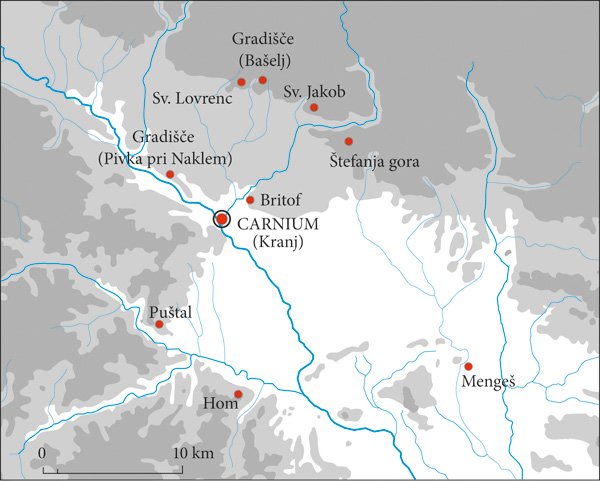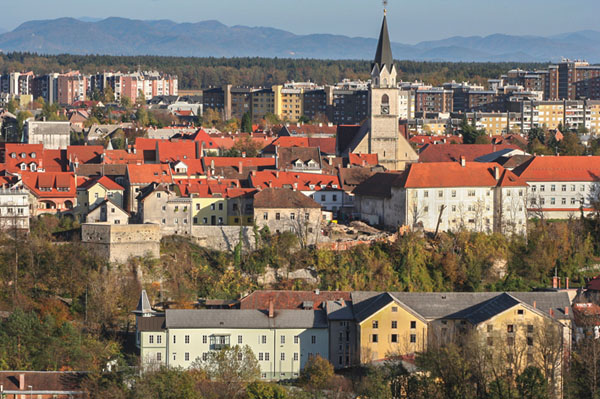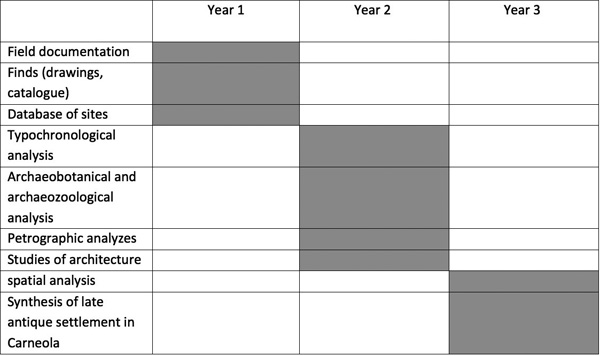Carnium and Carneola. The central settlement and its surroundings between antiquity and the Middle Ages
Principal Investigator at ZRC SAZU
-
Original Title
Karnij in Karneola. Centralno naselje in njegova okolica med antiko in srednjim vekom
Project Team
Benjamin Štular, PhD, Borut Toškan, PhD, Tjaša Tolar, PhD, Mateja Belak, Tilen Podobnik, dr. Tina Milavec-
ARIS Project ID
J6-50193
-
Duration
1 October 2023–30 September 2026 -
Link to SICRIS
20860 -
Project Leader
-
Financial Source

Partners
Univerza v Ljubljani, Filozofska fakulteta, Oddelek za arheologijo
Projekt je usmerjen v raziskovanje poznoantičnega in zgodnjesrednjeveškega obdobja na območju današnjih Gorenjske in osrednje Slovenije. Območje je v poznoantičnih pisnih virih zabeleženo kot pokrajina Karneola (Carneola). Najpomembnejše naselje v regiji je bilo Carnium (današnji Kranj), ki je igral pomembno vlogo v pestrem zgodovinskem dogajanju v 5. in 6. stoletju ter jo – kot eden redkih mest v tem območju – ohranil tudi v srednjem veku. S svojo lego na konglomeratnem pomolu nad sotočjem dveh rek je predstavljal središčno točko pokrajine, v kateri so bila ostala naselja postavljena predvsem na dobro zavarovanih višinskih lokacijah.

Carnium and the surrounding settlements
The project aims to identify the similarities and differences between Kranj as a multiethnic central settlement and the dependent, predominantly indigenous settlements. We analyse finds from unpublished field research at selected hilltop settlements and compare them with those from Carnium.

View of the city with Late Antique wall
As Kranj is one of the few Late Antique settlements in the region to live continuously into the Middle Ages, we also analyse the transition from the Late Antique to the Early Medieval period and the subsequent life of the settlement. In doing so, we rely mainly on the results of excavations in the vicinity of the parish church, where a large burial ground developed in the Early Middle Ages, with a continuity of burials from Late Antiquity into the modern period.
These issues are being explored in several sections:
- The architecture and residential culture of Carnium and selected hilltop settlements of Carneola: processing of archaeological, archaeozoological and archaeobotanical material.
- The involvement of the city and the region in economic and trade flows: the relationship between coarse and imported pottery; petrographic analyses; similarities and differences in supply with imported goods between the city and the surrounding settlements.
- Population movements, change in ethnic composition due to migration, relationship of newcomers with the natives: similarities and differences in the architecture and small finds in the city itself, between the city and the cemetery, and also between Carnium and the hilltop settlements. We are interested in what extent the differences observed can be linked to ethnic differences.
- Changes at the end of Late Antiquity – transformation of ancient urban settlements into Early Medieval forms of settlement: We are interested in the timing and manner of the transition from a Late Antique urban settlement, which still exhibited most of the elements of a city in the 6th century, to an Early Medieval settlement.
- Carnium and Carneola – the organisation and functioning of the landscape in Late Antiquity and the transition to the Early Middle Ages: a summary of the results of the analyses carried out in the first four sections.
Timeline
